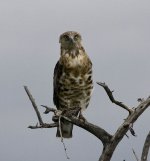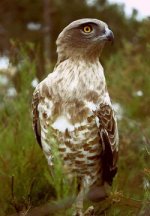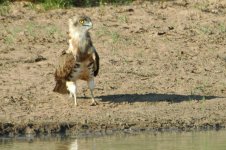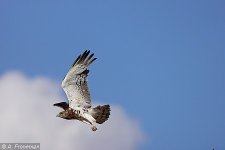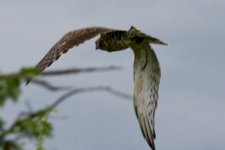-
Welcome to BirdForum, the internet's largest birding community with thousands of members from all over the world. The forums are dedicated to wild birds, birding, binoculars and equipment and all that goes with it.
Please register for an account to take part in the discussions in the forum, post your pictures in the gallery and more.
You are using an out of date browser. It may not display this or other websites correctly.
You should upgrade or use an alternative browser.
You should upgrade or use an alternative browser.
Unknown Hawk Namibia (1 Viewer)
- Thread starter Pluvius
- Start date
More options
Who Replied?Short Toed Eagle
Only similar its Beaudouin's Snake Eagle but it would have narrower and better arranged barrs on underparts, nartrower and more barrs to tail, deeper yellow-orangish iris, etc.
The other candidates are quite different
Andrea C
Ohhh, finally not a passerine
Only similar its Beaudouin's Snake Eagle but it would have narrower and better arranged barrs on underparts, nartrower and more barrs to tail, deeper yellow-orangish iris, etc.
The other candidates are quite different
Andrea C
Ohhh, finally not a passerine
Motmot
Eduardo Amengual
I am curious in that Short Toed Eagle is not found as far south as Namibia the only Circaetus species would be Black Chested Snake Eagle but pretty sure it is not this either.
I'm worried about that too. Are we all sure an imm Black-chested can't look similar? The thread bird is not too different from the imm shown on this link:
http://www.magikbirds.com/image.asp?title_id=285&show_thumbnails=True
Allan Hobbs
Body in the UK, heart in South Africa
Possibly late juvenile Black-breasted Snake Eagle, which is common in Namibia.
could it be a Black-chested immature, very late one, usually they have least and irregularly barred underparts, but it could be similar indeed
However, C.gallicus is reaching surely more to the south then usually reported...
Anyhow, I not so widely expert in S African species, just on WP and Asian one, I could ask Bill Clark and Dick Forsman to be sure about
And I did not check web or book, I could do now
However, C.gallicus is reaching surely more to the south then usually reported...
Anyhow, I not so widely expert in S African species, just on WP and Asian one, I could ask Bill Clark and Dick Forsman to be sure about
And I did not check web or book, I could do now
Steve G
RAINBIRDER
could it be a Black-chested immature, very late one, usually they have least and irregularly barred underparts, but it could be similar indeed
However, C.gallicus is reaching surely more to the south then usually reported...
Anyhow, I not so widely expert in S African species, just on WP and Asian one, I could ask Bill Clark and Dick Forsman to be sure about
And I did not check web or book, I could do now
I for one would be interested in hearing the opinions of raptor experts on this bird as my initial convictions have been eroded!
As I'm never prone to discart an ID solely/merely basing on distribution or likely of occurrence, as many years of birding let me thinking birds does not read our book and may turn up wherever (when I see my 1st Amur Falcon in Sicily I thought to be mad, then seen some others, same with Willet in W Italy this winter, etc. etc. ) neither I'm very prone to not try at least to understand a problem and clarify it in my mind, before eventually realising is not my job and asking somebody else (such as master Dick or Bill)...therefore I want to furnish a small analisis of this interesting bird, at least to be a good excuse for me to learn more about....
Its too easy to pass off an ID without giving reasons and being too selfsicure, even if in this case I'm also in favour of an imm. C.pectoralis being seen in Namibia (I thought initially to be Nigeria) ...
Anyhow, following some points to check and study:
age: a sub-adult (2nd to 3rd y) should show more variegated upperwing appearance by this time of the year, with many extremely abraded and pointed feathers, while the one visible in this bird seems to be ok for an adult! However, we need to see the open wing to check the moult pattern to be sure, and check the underwing pattern too and open tail.
legs: the tarsi of pectoralis seems to be longer than gallicus, less strong, with instead fingers shorter and thicher. In this bird the tarsi does not look so long, but the bird is in vertical posture, with legs and thigh feathers not wholly exposed, therefore very hard to judge.
iris: should be usually paler lemon yellow in pectoralis, without a slight but visible orangish hue or strong deep yellow. The pupil appear usually smaller in pectoralis than in gallicus, the eye in general remind me more a gallicus in our bird. But to subtle and not 100% objective characters.
underparts: they should be less barred, with barring mostly confined to upper breast and flanks by 8 to 12 months, later there should be much more barring, broader and darker barring, with the old one more rufous but the new one more widely dark, some almost wholly dark... the new one in our bird yet resembling gallicus-pattern in lower breast and flanks (I wonder, if there should be any white feathers as ault already in pectoralis by this time and age??). On upperbreats, there are some very dark feathers, as well as on throat and this, according to Clark & Paulson (Bull. BOC 2002) should be in favour of pectoralis...ok, but I wonder why not ok also for a dark female gallicus??!!
check pictures attacched ...
udertail: in pectoralis it seems that the uderface of tail, the undertail, in perched immature bird appear uniform, with not obviously marked and visible dark bar, in our bird is closer to gallicus. Also, usually in juv. to 2nd plumage pectoralis, the bars oftne are narrower, and sometimes not reaching the subterminal area. check pictures at :
http://www.wildlifephotography.co.z...le&PHPSESSID=48298303dcd010b1c258ff508564d40c
In any case, I think the ID problem is far more complex that said and that could appear, so we have to check more before being sure. I think our bird its rather identical to a gallicus, and I 1st thought was NIGERIA not NAMIBIA, but there are record further south of gallicus
However, I think it could be a pectoralis ok, but its very hard to be sure.
Attacched: a short-toed eagle to see the underparts barring and other characters
a 2nd plumage pectoralis to check the mentioned underparts barring, irirs, legs etc.
same
check the webpage too
Its too easy to pass off an ID without giving reasons and being too selfsicure, even if in this case I'm also in favour of an imm. C.pectoralis being seen in Namibia (I thought initially to be Nigeria) ...
Anyhow, following some points to check and study:
age: a sub-adult (2nd to 3rd y) should show more variegated upperwing appearance by this time of the year, with many extremely abraded and pointed feathers, while the one visible in this bird seems to be ok for an adult! However, we need to see the open wing to check the moult pattern to be sure, and check the underwing pattern too and open tail.
legs: the tarsi of pectoralis seems to be longer than gallicus, less strong, with instead fingers shorter and thicher. In this bird the tarsi does not look so long, but the bird is in vertical posture, with legs and thigh feathers not wholly exposed, therefore very hard to judge.
iris: should be usually paler lemon yellow in pectoralis, without a slight but visible orangish hue or strong deep yellow. The pupil appear usually smaller in pectoralis than in gallicus, the eye in general remind me more a gallicus in our bird. But to subtle and not 100% objective characters.
underparts: they should be less barred, with barring mostly confined to upper breast and flanks by 8 to 12 months, later there should be much more barring, broader and darker barring, with the old one more rufous but the new one more widely dark, some almost wholly dark... the new one in our bird yet resembling gallicus-pattern in lower breast and flanks (I wonder, if there should be any white feathers as ault already in pectoralis by this time and age??). On upperbreats, there are some very dark feathers, as well as on throat and this, according to Clark & Paulson (Bull. BOC 2002) should be in favour of pectoralis...ok, but I wonder why not ok also for a dark female gallicus??!!
check pictures attacched ...
udertail: in pectoralis it seems that the uderface of tail, the undertail, in perched immature bird appear uniform, with not obviously marked and visible dark bar, in our bird is closer to gallicus. Also, usually in juv. to 2nd plumage pectoralis, the bars oftne are narrower, and sometimes not reaching the subterminal area. check pictures at :
http://www.wildlifephotography.co.z...le&PHPSESSID=48298303dcd010b1c258ff508564d40c
In any case, I think the ID problem is far more complex that said and that could appear, so we have to check more before being sure. I think our bird its rather identical to a gallicus, and I 1st thought was NIGERIA not NAMIBIA, but there are record further south of gallicus
However, I think it could be a pectoralis ok, but its very hard to be sure.
Attacched: a short-toed eagle to see the underparts barring and other characters
a 2nd plumage pectoralis to check the mentioned underparts barring, irirs, legs etc.
same
check the webpage too
Attachments
Underwing looks ok for pectoralis, with clean underwing coverts , retained secondaries narrowely barred at the base but not at the tip, and moultde new primaries instead with above a very strong and dark and solid (sub) terminal bar...
A very interestoing and leanring case
thanks
Andrea C
I will ask Bill or Dick to write together some notes on ID on immatures Circaetus sp. as its seems to be the case ....
However, they are both writing hanbdbook on African raptors so...
just wait for them
A very interestoing and leanring case
thanks
Andrea C
I will ask Bill or Dick to write together some notes on ID on immatures Circaetus sp. as its seems to be the case ....
However, they are both writing hanbdbook on African raptors so...
just wait for them
Similar threads
Users who are viewing this thread
Total: 2 (members: 0, guests: 2)




